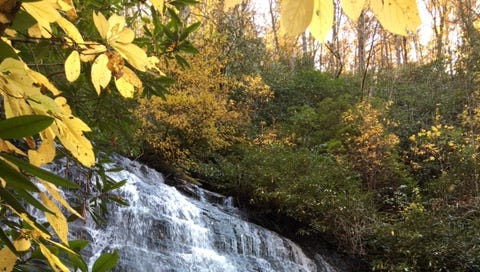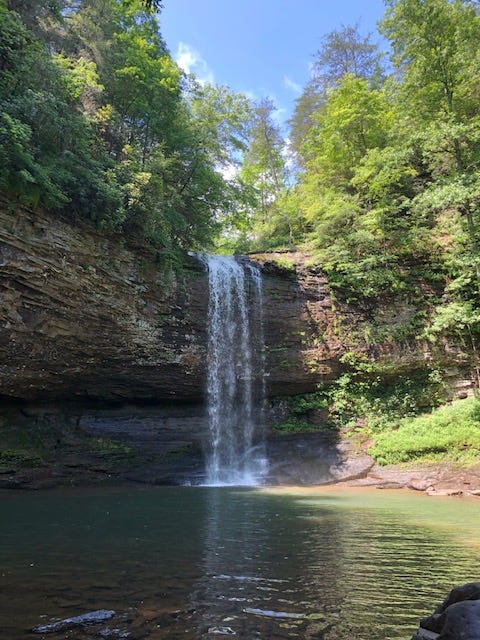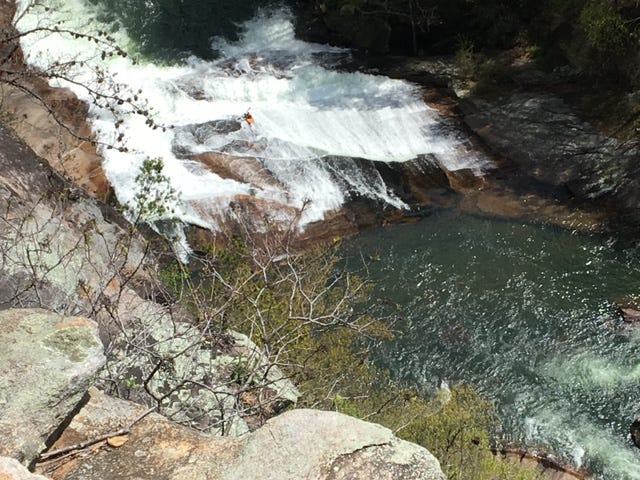Thank you and WELCOME! to all of our new subscribers over the past several weeks! I’ve loved seeing our community grow very steadily over time. This issue is my 19th, and my list of Natural Wonders questions for future newsletters just keeps getting longer, rather than shorter - thanks to so many of you who offer suggestions for upcoming issues. Keep those ideas coming, and forward this email on to someone you think might enjoy it!
Welcome to Natural Wonders, where I hope to pique your interest each week by sharing some fascinating questions and answers about natural phenomena. If you’re new here or if someone forwarded you this email, you can subscribe below.
Check out past posts by going here and see who I am and what Natural Wonders is about here.
There’s just something about visiting a waterfall, isn’t there? The sound of the water cascading over rocks, the turbulent, boiling water in the pool below, the mist blowing on your face, the pure energy evident in the roar of the water. We all seem to love waterfalls.
People hike long trails just to see the waterfall at the end. We stand entranced and watch the flume pour over the edge. Kids play in the spray below. Newlyweds honeymoon nearby, daredevils dive too close in wingsuits, resorts build expensive lodging right at the edge. Why is this? Why are we so fascinated by water moving from a higher location to a lower one? Why are we drawn to visit when we could otherwise be terrified by them, or just plain bored?
Last week was my birthday, so Andrew and I loaded up Oscar and went on a short Tour de Waterfalls in the nearby foothills. We visited three separate falls, each only a mile or two hike. It was a gorgeous day, the weather was warm and sunny, and since it was a weekday there were almost no people on the trails.
Minnehaha Falls, above, was about 100 feet tall and the largest waterfall we visited. It was roaring, with a wind created by the rushing water blowing over us as we sat and took it all in. It was here, as we all but meditated just listening to the water, that I began to wonder about the draw of waterfalls on humans. Do they change our mood somehow? Does everyone find them peaceful, or is that just me?
Why do we love to visit waterfalls?
While there may be many factors that contribute to our love of waterfalls (the lower temperature on a hot day, the visually mesmerizing flow of the water, the overall sensory input of the falls), scientists have found that waterfalls are soothing to humans due to the Lenard effect, also known as spray electrification or the waterfall effect. Essentially, waterfalls create “charged particles” called negative ions that have a positive effect on our wellbeing.
What are negative ions? They are molecules floating in the air that are charged with electricity. When water collides with itself, the water droplets are broken apart and separate charges are created – the larger droplets contain a positive charge while the fine mist carries a negative charge.
Negative ions can change our mood in a positive way. You’ll find a wide range of claims online about the various positive effects, but research has shown that exposure to these negative ions can reduce symptoms of depression, improve the effects of seasonal affective disorder (SAD), boost your immune system, and even activate cognitive performance. In an article on WebMD, Pierce J. Howard, PhD, author of The Owner’s Manual for the Brain: Everyday Applications from Mind Brain Research says, “Generally speaking, negative ions increase the flow of oxygen to the brain; resulting in higher alertness, decreased drowsiness, and more mental energy."
Studies have not yet proven other claims of the positive effects of negative ions, such as decreasing serotonin, improving breathing, or reducing blood pressure.
Check out this paddler, getting his fill of negative ions while also probably raising his blood pressure as he runs the Tallulah River Gorge:
It turns out negative ions aren’t just created in waterfalls. They’re also created when lightning discharges energy into the atmosphere, by UV rays from the sun, as well as from the normal growth of plants. Just getting outside and Forest Bathing will expose you to good negative ions even if a waterfall isn’t nearby.
Are you a person who likes to take long showers? Perhaps you’re instinctively getting your negative ion fix – it’s the one place in most every home that naturally produces these molecules.
While negative ions have lots of benefits, positive ions do not. Exposure to positive ions can create unpleasant effects on your mood as well as affect your joints and irritate your breathing. In nature, positive ions are created by dust storms, strong winds, humidity, and pollution. Right before a lightning storm, positive ions are at very high levels: think about the combination of energy/anxiety/irritability you feel when a storm is looming – that’s because of all the positive ions in the air. You’d probably feel better if you went and took a shower. Or, you could just wait for that crisp air feeling after a storm has passed – that’s the result of negative ions in the air!
We are exposed to a lot of positive ions in our urban lives – in our cell phones, cars, and indoors at work or while shopping. Devices that create an electromagnetic field produce positive ions: cell phones, computer monitors, and other electronic devices such as printers, photocopiers, fluorescent lights and TVs. Could this partly be why we feel irritable and exhausted from a long day of work surrounded by machines? Or why we feel sluggish after a day when we’ve been stuck to a device? Time to get out and visit a waterfall!
One widely acknowledged silver lining of the pandemic has been a significant increase in people seeking activities in the outdoors. People are taking part in the 52-hike challenge, posting their outings on Facebook Groups, and testifying to the life-changing positive results they’ve experienced from getting outside. Just last week I met a woman at our local bike trails who left her gym because of the pandemic and bought a mountain bike – she was extremely enthusiastic about her love for the outdoors. Perhaps what these folks have all inadvertently discovered is the positive effects of the negative ions that occur in nature. Maybe this is just the scientific confirmation of what we have known all along, that Nature is good for us and makes us happy.
What is your favorite waterfall? Have you noticed the positive effects of negative ions? Let us know what you think!
Nature Break: Find a waterfall near you to go visit. Spend some time at the base of the falls, close enough to feel the breeze wafting off the water. Sit for a while and observe the area - what plants are dependent on the falls? Can you see living things (snails, minnows) in the water? Try to follow one small patch of water with your eyes as it travels over the edge. Then pay attention to yourself - do you feel energized and mentally sharper?
Weird Nature of the Week

Detritus
Check out this fake tortoise shell, originally 3-D printed by a high school student, that trains ravens to stay away from baby tortoises. If you remember my post from last week about crows, you’ll remember how intelligent corvids are and how quickly they learn – this plastic shell attracts the ravens then squirts them with artificial grape juice to startle them away when they try to eat this threatened species.
Scientists have thought of octopuses as loners in the marine world, basically living on their own rather than in clusters or herds (or “murders”). But a discovery of two “octopus’ communities” shows they can live together, fighting over territory by throwing shells at one another, boxing, and “mantling up” so they look somewhat like vampires. Those of you who’ve read the amazing Soul of an Octopus will not be surprised by these revelations, but the accompanying videos are pretty cool!
Substack, the platform through which I publish these newsletters, now has an app for iPhones where you can read if you don’t want to receive issues via email. If you’re interested, click the link below:
If you’re enjoying this newsletter, please take a moment and share it with two of your friends you think would enjoy it too. Or just click the “like” button at the bottom - that always warms my heart!












I love waterfalls, because I like geology, I like the constant motion and the force of it. The sound. The water following every possible corner. The water flowing over a corner vs over a small part of an all-horizontal cliff. Unless it's longer than it is tall. Or really narrow compared to the height. So it's either a very tall waterfall, or it's like a long trail of water down the cliff. In many locations, waterfalls could be made larger by changing the landscape. But to rather preserve a natural waterfall, others could be made by excavation and linking it with a river. But for local arch cliffs near me, from prehistoric or occasional waterfalls, I just wish that the State would just dig out a well, install a pump to set water flowing over the edge, install another pump downstream to pump the water back to the top of the cliff to save water of excess. But meanwhile, continue to use water from the well to maintain the amount of flowing water against evaporation. As for electricity to power the pumps, as well as costs, install solar panels nearby but out of sight from the waterfall. Enough solar panels to not just to justify the monthly costs of electricity for the pumps, but enough solar panels to justify the entire project. Soon, even the costs of the solar panels, as well as annual taxes would be justified. A complete circular waterfall could even be made. And an arch in the cliff would allow the water to flow out. But it won't be visually noticeable, since the view of the hole in the cliff would be blocked by part of the waterfall. If the hole were entirely below the lower water level, extend past and beyond the waterfall, before extending up to the lower water level, then the outlet would not cause the lower water level to drop too low, where the outlet could be seen. And rather than the water flowing out where it can be seen, the water in the underground tunnel could be connected to the pump. So it would look like a complete circular waterfall, a lower water level, with no sight of where the water goes beyond, or where it returns to the top, nor any hint of the water at the bottom going anywhere. It would be sort of like a natural pool. With the water apparently not going anywhere. And the amount of water spilling down even adding to the amount of water at the bottom noticeably. Because the lower water level would never increase.
I love waterfalls! Thanks for this insight into why that might be so. Whenever my husband and I go hiking, seeing a water feature of some sort is always high on the destination list.